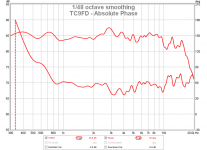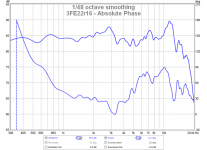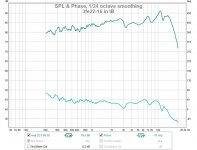What about a reverse of the above, sound from inexpensive speakers played back through audiophile grade speakers?
Perhaps I'm missing something, how can you critique a speaker listening to it through another speaker?
Use good headphones as stated in post 1 unless you have reference grade monitors. Most of the differences are from 600Hz up to 18kHz. If your headphones or speakers cover that well, you will hear differences.
All headphones are not created equal, surely?Use good headphones as stated in post 1 unless you have reference grade monitors. Most of the differences are from 600Hz up to 18kHz. If your headphones or speakers cover that well, you will hear differences.
I think your contribution, no matter how hard you worked, has as much to do with fidelity as that of the kids that showcase their mini amps and speakers on Youtube.
OK, I think I understand, the forum is by fanatics, for fanatics.
I Googled fanatics and this came up,
"A person marked or motivated by an extreme, unreasoning enthusiasm"
Also Googled Forum,
"A place, meeting, or medium where ideas and views on a particular issue can be exchanged".
So, we do not have to be in agreement.
I Googled fanatics and this came up,
"A person marked or motivated by an extreme, unreasoning enthusiasm"
Also Googled Forum,
"A place, meeting, or medium where ideas and views on a particular issue can be exchanged".
So, we do not have to be in agreement.
All headphones are not created equal, surely?
I think your contribution, no matter how hard you worked, has as much to do with fidelity as that of the kids that showcase their mini amps and speakers on Youtube.
These files are quite a bit more controlled and accurate than anything recorded with a cel phone mic and posted to youtube.
If you listen to them on a speaker (headphone or otherwise) that you've become accustomed to, and mostly "ear blind" to, meaning your brain has adapted to their minor aberrations, I think this test, for the sole purpose of gathering what people think of the tonality of these drivers, is perfectly serviceable...and without reasonable alternative over the internet.
Tests like this require relative judgement... You calibrate your ears to the original track and keep re-referencing it as you explore the differences of each file... Regardless of your speaker system (as long as it's not beyond hope) you should be able to judge the differences and from that make some conclusion. The ears and brain become accustomed to whatever their *normal* source system is (and treat it as normal), so deviations are immediately noticeable when using this method regardless of the users speaker FR/transient reproduction.
Mastering engineers do this all day long everyday... Their speakers are not perfect, (but damn good), and yet they still reference the source file as they make changes (just like these tests ask the listener to do)... Headphones are also used frequently (but not for tuning space (reverbs/delays/etc) or bass).
Anyhow headphones for this test was a pretty reasonable recommendation, but the people listening on laptop speakers, um, that's like sunglasses at night, I mean, sure, you can see when there are lights ahead, but is it a car or a streetlight?
I'm enthusiastic that we can do these subjective tests. They're especially cool (to me) in that they encourage everyone to consider their own systems influence on their final choice, (for instance E&G won't sound good on systems that are already tilted downwards as they climb into the hf).
Mastering engineers go through similar evaluation processes of their systems even up to getting their ears profiled to learn their own Fletcher-Munson/loudness contours... I can't see any reason why audiofiles and speaker designers shouldn't do the same?
Last thing I wanted to mention; some people have noticeably better detection of timing information than FR and vice versa.. I work with an engineer who used to be a drummer and is now losing his hearing above 9khz in one ear (above 12 in the other) however, his ability to recognize harmonic distortion and transient purity is much better than mine while I have better acuity of frequency response and pitch. He designs musical instruments (one of the better designers I've met) and this benefits him as lower frequency fundamental harmonic purity is a concern in his work... But yeah this reinforces the conclusion that people develop different listening strengths. For instance the 3fe22 had a strange phase aspect (300-700hz?) that bothered me and I think I was one of the only ones noticing it... Or maybe I was just imagining things,,, 😱
Mastering engineers do this all day long everyday... Their speakers are not perfect, (but damn good), and yet they still reference the source file as they make changes (just like these tests ask the listener to do)... Headphones are also used frequently (but not for tuning space (reverbs/delays/etc) or bass).
Anyhow headphones for this test was a pretty reasonable recommendation, but the people listening on laptop speakers, um, that's like sunglasses at night, I mean, sure, you can see when there are lights ahead, but is it a car or a streetlight?
I'm enthusiastic that we can do these subjective tests. They're especially cool (to me) in that they encourage everyone to consider their own systems influence on their final choice, (for instance E&G won't sound good on systems that are already tilted downwards as they climb into the hf).
Mastering engineers go through similar evaluation processes of their systems even up to getting their ears profiled to learn their own Fletcher-Munson/loudness contours... I can't see any reason why audiofiles and speaker designers shouldn't do the same?
Last thing I wanted to mention; some people have noticeably better detection of timing information than FR and vice versa.. I work with an engineer who used to be a drummer and is now losing his hearing above 9khz in one ear (above 12 in the other) however, his ability to recognize harmonic distortion and transient purity is much better than mine while I have better acuity of frequency response and pitch. He designs musical instruments (one of the better designers I've met) and this benefits him as lower frequency fundamental harmonic purity is a concern in his work... But yeah this reinforces the conclusion that people develop different listening strengths. For instance the 3fe22 had a strange phase aspect (300-700hz?) that bothered me and I think I was one of the only ones noticing it... Or maybe I was just imagining things,,, 😱
Last edited:
radiosmuck,
View point is fine and as you say about forums we do not have to be in agreement.
Right it sounds a bad idea just take listen one speaker thru another no matter if route is a premium to junk or junk to premium speaker, one have no reference there. Think you miss the hole point that you should compare i repeat compare the ones recorded under same conditions and in that process reference them to each other under the conditions your listening setup is able to perform, then pick the one you prefer.
Feel free to not agree but hope this helps what us doing the test think can be done.
Now regarding your google post, it seems not so diplomatic, here another door if one just want a argument, Argument Clinic - Monty Python's The Flying Circus https://www.youtube.com/watch?v=kQFKtI6gn9Y.
View point is fine and as you say about forums we do not have to be in agreement.
Right it sounds a bad idea just take listen one speaker thru another no matter if route is a premium to junk or junk to premium speaker, one have no reference there. Think you miss the hole point that you should compare i repeat compare the ones recorded under same conditions and in that process reference them to each other under the conditions your listening setup is able to perform, then pick the one you prefer.
Feel free to not agree but hope this helps what us doing the test think can be done.
Now regarding your google post, it seems not so diplomatic, here another door if one just want a argument, Argument Clinic - Monty Python's The Flying Circus https://www.youtube.com/watch?v=kQFKtI6gn9Y.
Last edited:
Who is to say that purchasing a preferred speaker after using the testing of a speaker through another speaker would not produce disappointment?
It's no different than choosing a TV based on the image of another TV, if you get my drift?
Think of Sony ad, trying to show off their super HD TV on your old 720p
It's no different than choosing a TV based on the image of another TV, if you get my drift?
Think of Sony ad, trying to show off their super HD TV on your old 720p
Who is to say that purchasing a preferred speaker after using the testing of a speaker through another speaker would not produce disappointment?
Probably the same people who would buy a speaker based on how it sounds in a store, considering the room is a hugely significant influence.
Besides, I don't think anyone is trying to sell any of these drivers, it's just a subjective experiment. Even if they were, this experiment, no matter how flawed, still presents a person with some auditory information about a driver than what people normally rely on when selecting a driver, namely the subjective opinion of someone else.
What represents more information:
A: Buy this driver, I think it sounds good.
B: Buy this driver, I think it sounds good, and here's a (albeit flawed) recording of it.
RS,
The point you are missing is that it is a relative comparison. Doesn't matter what you are using to listen - heck, as Anthony Bisset pointed out, our ear response functions are different. The unique point of this test is that everything (speaker, room, wires, electronics, music source, recording mic, etc) was identical except for the change in the driver unit. So whatever *DIFFERENCE* you hear HAS to be a result of the change in the driver.
The point you are missing is that it is a relative comparison. Doesn't matter what you are using to listen - heck, as Anthony Bisset pointed out, our ear response functions are different. The unique point of this test is that everything (speaker, room, wires, electronics, music source, recording mic, etc) was identical except for the change in the driver unit. So whatever *DIFFERENCE* you hear HAS to be a result of the change in the driver.
Anthony Bisset also pointed out there was a phase "problem" with Faital recording. Do you have any data on phase behavior of these units that supports that difference of Faital, compared to all 6 others in same test?
Anthony Bisset also pointed out there was a phase "problem" with Faital recording. Do you have any data on phase behavior of these units that supports that difference of Faital, compared to all 6 others in same test?
I have the minimum phase data - let me look that up.
Do I get to file a disclaimer? 🙂.. . It was only on a few a/b comparisons that I detected it and when I came back to it later it went inaudible. It felt like the fundamental <> 2nd harmonic temporal relationship (for that lower region) was skewed. But this could easily be my education creating an explanation for my imagination rather than just admitting that 20 minutes into the comparison I was getting bored and not focusing or had tilted my head in a way that produced a different response and wasn't being mindful of listening position. Small changes in head position radically alter what we hear so I'm always laughing when audiophiles change out cables and then stand up and announce an improvement. Of course, you just moved in the room, you're hearing all sorts of new stuff!...
Detecting a fixed phase difference is *really truly* at the threshold of human listening/memory ability so I'm skeptical of my observation but look forward to seeing the data. Fwiw, my primary complaint with that driver was the peak above 12 or 13khz (nothing EQ couldn't solve with grace and minimal artifact).
Detecting a fixed phase difference is *really truly* at the threshold of human listening/memory ability so I'm skeptical of my observation but look forward to seeing the data. Fwiw, my primary complaint with that driver was the peak above 12 or 13khz (nothing EQ couldn't solve with grace and minimal artifact).
Last edited:
Do I get to file a disclaimer? 🙂.. . It was only on a few a/b comparisons that I detected it and when I came back to it later it went inaudible. It felt like the fundamental <> 2nd harmonic temporal relationship (for that lower region) was skewed. But this could easily be my education creating an explanation for my imagination rather than just admitting that 20 minutes into the comparison I was getting bored and not focusing or had tilted my head in a way that produced a different response and wasn't being mindful of listening position. Small changes in head position radically alter what we hear so I'm always laughing when audiophiles change out cables and then stand up and announce an improvement. Of course, you just moved in the room, you're hearing all sorts of new stuff!...
Detecting a fixed phase difference is *really truly* at the threshold of human listening/memory ability so I'm skeptical of my observation but look forward to seeing the data. Fwiw, my primary complaint with that driver was the peak above 12 or 13khz (nothing EQ couldn't solve with grace and minimal artifact).
Well, there may actually be something to your super-tuned phase-modulated echo-location bat ears after all...
Here is the absolute phase for TC9FD vs 3FE22r16 (4ms gate):
TC9FD
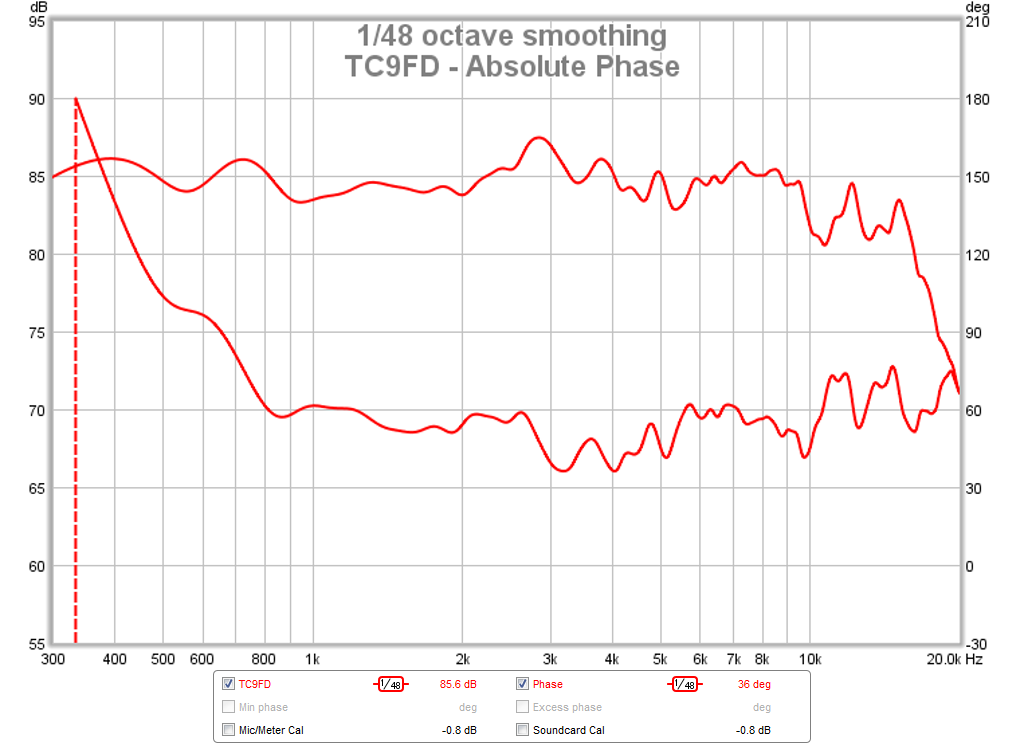
3FE22r16
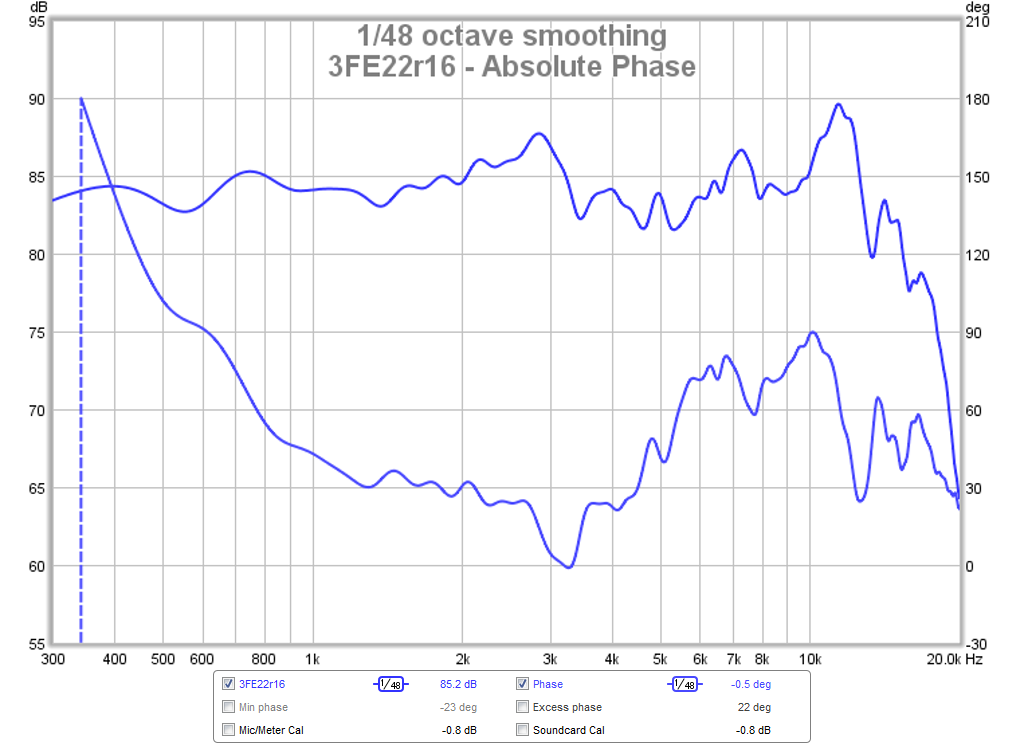
There is sharp phase dip at 3.3kHz followed by a rise to 10kHz with 3FE22 whereas it is relatively flat with TC9FD, but all this would flatten out with some mild EQ I think.
Attachments
Last edited:
Oh, interesting, looking at my original listening notes in post #34:
http://www.diyaudio.com/forums/full-range/270614-subjective-blind-comparison-3in-5in-full-range-drivers-4.html#post4243215http://
It says I was jumping between the Mark Audio and the Faital as least favorites... Hey X, when you look at the data, maybe see if the Mark Audio has phase shift that I might have incorrectly memorized as correct during comparison and then faulted the Faital.
Even if there is a shift it probably doesn't matter much. Temporally small fixed phase issues are rarely a problem for humans. Crossovers and EQs induce phase shift that most comfortably accept. I've read that most people don't even notice the absolute phase of a system being flipped, even though LF transients are fully reversed (kick drums suck in on what should be their attack). A long time ago I did some experiments with absolute phase being flipped and only on a few specific tracks could I tell the difference, most material (inverted or normal) sounded the same.
http://www.diyaudio.com/forums/full-range/270614-subjective-blind-comparison-3in-5in-full-range-drivers-4.html#post4243215http://
It says I was jumping between the Mark Audio and the Faital as least favorites... Hey X, when you look at the data, maybe see if the Mark Audio has phase shift that I might have incorrectly memorized as correct during comparison and then faulted the Faital.
Even if there is a shift it probably doesn't matter much. Temporally small fixed phase issues are rarely a problem for humans. Crossovers and EQs induce phase shift that most comfortably accept. I've read that most people don't even notice the absolute phase of a system being flipped, even though LF transients are fully reversed (kick drums suck in on what should be their attack). A long time ago I did some experiments with absolute phase being flipped and only on a few specific tracks could I tell the difference, most material (inverted or normal) sounded the same.
Who is to say that purchasing a preferred speaker after using the testing of a speaker through another speaker would not produce disappointment?
It's no different than choosing a TV based on the image of another TV, if you get my drift?
Think of Sony ad, trying to show off their super HD TV on your old 720p
Think not a good point the Sony one, as xrk971 set up the comparison the Sony ad should look like this:
Sony set up their model and 6 competitors plus a high end fully calibrated reference screen under exactly same conditions. You can now sit switching between the 7 competitors and the reference screen as long and many times you like, judging their *DIFFERENCE* up against the reference one via your old 720p.
At post #1 xrk971 link to the source tracks in 320kbit mp3 format for use as reference, these are same as the above calibrated high end fully calibrated reference screen.
Regarding produce disappointment there could be flaws in many of the reasons to make a decision for a product, here some, and no one say others should buy drivers based on this comparison but some do and please let them. Others again buy based on datasheets, some buy base on the look, some what they recommended by others, some what they hear in a shop with very different gear and acoustic environment than is present their actual home, and some probably a mix off all or whatever.
Oh interesting to see... That's not that much shift, is it?
What do the other drivers look like?
*Maybe* this helps me understand why I didn't like the treble on the 3fe22... I originally attributed its HF harshness to the peak I could hear above 12k, but it the feeling was more broadband than just that peak, but its very hard to imagine 15deg of shift from 3k to 10k (~1.7octaves) would be noticeable...
The phase issue I noticed seemed much lower, like 300-700hz and was in comparison of the Mark Audio and 3fe22.
I do think that amount of phase shift might be noticeable when flipping a/b style between sources, if ones acoustic memory is really good, but even so, I can't see how the impression would ghost to lower frequencies...
What do the other drivers look like?
*Maybe* this helps me understand why I didn't like the treble on the 3fe22... I originally attributed its HF harshness to the peak I could hear above 12k, but it the feeling was more broadband than just that peak, but its very hard to imagine 15deg of shift from 3k to 10k (~1.7octaves) would be noticeable...
The phase issue I noticed seemed much lower, like 300-700hz and was in comparison of the Mark Audio and 3fe22.
I do think that amount of phase shift might be noticeable when flipping a/b style between sources, if ones acoustic memory is really good, but even so, I can't see how the impression would ghost to lower frequencies...
I haven't done any *serious* experiments with phase, but word on the street is phase shouldn't be much of a discussion point above 4khz since our ability to localize ends up there. So how do we acquire pitch above 4khz then?
Here is an interesting paper / quick read on the topic:
http://arxiv.org/ftp/arxiv/papers/1206/1206.1864.pdf
This is talking about entrainment with single frequencies (which is necessary for their experiment) but I do wonder how a mismash of overlapping harmonics going through some phase shift would make harmonic acquisition less distinct or would perceptually seem to have more energy even though the FR was less.. As in less clarity is interpreted as more significant thus awareness attributes extra focus to that region, end result is we perceive it as brighter than it really is... Okay, taking my conjecture goggles off... *That is* a fun water-slide.
Here is an interesting paper / quick read on the topic:
http://arxiv.org/ftp/arxiv/papers/1206/1206.1864.pdf
This is talking about entrainment with single frequencies (which is necessary for their experiment) but I do wonder how a mismash of overlapping harmonics going through some phase shift would make harmonic acquisition less distinct or would perceptually seem to have more energy even though the FR was less.. As in less clarity is interpreted as more significant thus awareness attributes extra focus to that region, end result is we perceive it as brighter than it really is... Okay, taking my conjecture goggles off... *That is* a fun water-slide.
- Status
- Not open for further replies.
- Home
- Loudspeakers
- Full Range
- A Subjective Blind Comparison of 3in to 5in Full Range Drivers
